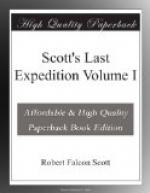As we came to camp a blizzard threatened, and we built snow walls. One hour after our arrival the wind was pretty strong, but there was not much snow. This state of affairs has continued, but the ponies seem very comfortable. Their new rugs cover them well and the sheltering walls are as high as the animals, so that the wind is practically unfelt behind them. The protection is a direct result of our experience of last year, and it is good to feel that we reaped some reward for that disastrous journey. I am writing late in the day and the wind is still strong. I fear we shall not be able to go on to-night. Christopher gave great trouble again last night—the four men had great difficulty in getting him into his sledge; this is a nuisance which I fear must be endured for some time to come.
The temperature, -5 deg., is lower than I like in a blizzard. It feels chilly in the tent, but the ponies don’t seem to mind the wind much.
The incidence of this blizzard had certain characters worthy of note:—
Before we started from Corner Camp there was a heavy collection of cloud about Cape Crozier and Mount Terror, and a black line of stratus low on the western slopes of Erebus. With us the sun was shining and it was particularly warm and pleasant. Shortly after we started mist formed about us, waxing and waning in density; a slight southerly breeze sprang up, cumulo-stratus cloud formed overhead with a rather windy appearance (radial E. and W.).
At the first halt (5 miles S.) Atkinson called my attention to a curious phenomenon. Across the face of the low sun the strata of mist could be seen rising rapidly, lines of shadow appearing to be travelling upwards against the light. Presumably this was sun-warmed air. The accumulation of this gradually overspread the sky with a layer of stratus, which, however, never seemed to be very dense; the position of the sun could always be seen. Two or three hours later the wind steadily increased in force, with the usual gusty characteristic. A noticeable fact was that the sky was clear and blue above the southern horizon, and the clouds seemed to be closing down on this from time to time. At intervals since, it has lifted, showing quite an expanse of clear sky. The general appearance is that the disturbance is created by conditions about us, and is rather spreading from north to south than coming up with the wind, and this seems rather typical. On the other hand, this is not a bad snow blizzard; although the wind holds, the land, obscured last night, is now quite clear and the Bluff has no mantle.
[Added in another hand, probably dictated:
Before we felt any air moving, during our A.M. march and the greater part of the previous march, there was dark cloud over Ross Sea off the Barrier, which continued over the Eastern Barrier to the S.E. as a heavy stratus, with here and there an appearance of wind. At the same time, due south of us, dark lines of stratus were appearing, miraged on the horizon, and while we were camping after our A.M. march, these were obscured by banks of white fog (or drift?), and the wind increasing the whole time. My general impression was that the storm came up from the south, but swept round over the eastern part of the Barrier before it became general and included the western part where we were.]




